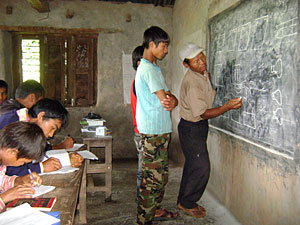 |
Even advocates of renewable energy gave up on the prospect of wind power in Nepal when the two 10KW wind generators in Kagbeni and Mustang were blown away in 1989. The damage extended beyond that to the generators. In the years to come, no serious efforts were made either to repair the plant or to set up other projects on such a scale. Complications with other wind projects reinforced the idea that wind power was not viable in Nepal.
So it was no less than a breakthrough when in 2009 a group of students from an engineering college in Kathmandu set up a 2KW wind turbine, using their own resources. The turbine that stands tall on the roof of Kathmandu Engineering College in Kalimati (pic, above) generates enough electricity to power the computer lab and library of the college and is much more powerful than most wind turbines set up by the government and NGOs across the country, most of which produce 200-600W for lighting purposes only.
"It took us little more than a month to set up the turbine. We used locally available materials, some of which even came from the junkyard, and built a fully functioning wind power plant at a very reasonable price. We wanted to prove that wind power can work in Nepal," says Amrit Singh Thapa, who led the group. The same year, they went on to set up the tallest turbine in Nepal, a 1.5KW generator at a resort in Lakhuri Bhanjyang (pic, below), and now Thapa heads a private company that promotes wind energy.
 |
With the declaration of 2009 as alternative energy year, the government announced a program to generate 20MW of electricity from wind energy in and around the Kathmandu Valley through public-private partnerships. There are also plans to build a model wind farm of 500KW and provide assistance to small-scale wind turbine manufacturers generating less than 10KW. But though a 20MW wind project is in the pipeline, government officials say the focus for the time being will be on smaller rural projects of a few hundred watts rather than utility-scale projects.
Many experts rightly point out that wind or solar power can never be an alternative for hydropower, especially in a country like Nepal. But relatively quick and easy installation can make wind power plants a feasible option for places unconnected to the grid where micro-hydropower plants are not possible. "The government's policy is to promote wind power in places where wind can be harnessed and communities can be given some respite before the grid can make it there," AEPC's Narayan Adhikary explains.
The private sector says the government should at least create an investment-friendly environment for companies willing to invest. "The national wind policy, the draft of which was prepared months ago, has not been finalised," says Thapa.
Nischal Shrestha of Krishna Grill Engineering Works, Mandikhatar, echoes this concern. "We know that there is an immense possibility for wind power but investors will not move forward unless there are proper policies and provisions in place." Adhikary concedes: "With the data we have now, it will be very hard to draw in foreign investors."
Energy village
 |
Given the power shortages in the capital, remote rural areas have a long wait ahead. Where micro-hydropower plants are not feasible either, the grid could take decades to arrive.
But Thanatole, a small Magar settlement, in Nawalparasi, is proving that hydro isn't the only renewable energy source on the block. Wind and solar power in Hurhure Danda (pic, right) is generating 600W of electricity for the 45-household community, which uses this power for lighting and to charge mobile phones. "It would have taken at least another 10 years for this village to be connected to the grid. Projects such as these, albeit small in scale, will at least ease their immediate power needs," says Surbir Sthapit of HICODEF, which has been implementing this project with the support of Practical Action.
The project is not without its problems. The wind turbines have been acting up and the community is relying solely on solar for the moment. "Mostly problems arise due to poor manufacturing and the lack of proper repair and maintenance in remote areas," Pushkar Manandhar of Practical Action says. "But because we have installed a hybrid system, one system can provide continuous supply when there are problems with the other." Practical Action has built 23 wind turbines across the country.
 Members of the Hurhure Danda Renewable Energy Users Committee learn about electricity |
Hurhure Danda is also being developed into a model energy village. There are plans to set up ten biogas plants and provide villagers with improved cooking stoves that minimise indoor pollution and are more energy efficient.
Wind systems in Nepal
* Solar-wind hybrid system in Pyuthan, 400W, built by Krishna Grills
* Wind power plant in Pyuthan, 1.5KW, built by AEPC
* 23 wind turbines across the country, 200-600W capacity each, built by Practical Action
* 10 turbines in Nagarkot, 1KW each, built by the Nepal Army
* Wind turbines in Kathmandu Engineering College and Lakhuri Bhanjyang, 2KW and 1.5KW, built by Amrit Singh Thapa and friends, www.eenergys.com, [email protected]
READ ALSO:
Chain reaction, RICHARD BULL


